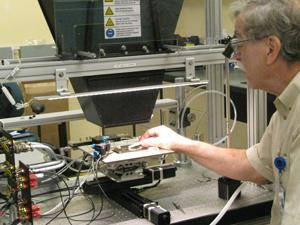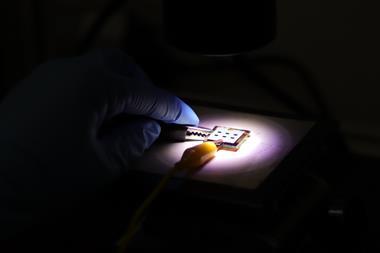Testing procedures and device instability mean performance may be inflated

The sun has certainly been shining for perovskite solar cells in recent years. First created in 2012, perovskite solar cells have shown great promise as an affordable alternative to other solar technologies and their performance has gone from strength-to-strength. Reports now suggest they are capable of efficiencies greater than 20% – a milestone which took other solar cells decades to reach.
But how realistic are these efficiency values? This question is now being asked by national laboratories, with a cluster of research groups finding that the very nature of efficiency testing, as well as the questionable stability of perovskites themselves, is only serving to exaggerate device performance. And unless this stability problem can be solved perovskite devices may never become a viable alternative to silicon solar cells.
‘All the exciting efficiencies and any energy claims that are associated with [perovskite solar cells] should be taken with a grain of salt,’ according to Keith Emery, the manager of the National Renewable Energy Laboratory’s (NREL) photovoltaic cell and module performance characterisation group in the US. NREL are one of several international laboratories tasked with ensuring that any claims of improved solar cell efficiency are independently verified and held to a robust standard. It is standard practice to test a cell by performing a current–voltage measurement on it. The cell is irradiated with 1000W/m2 of light at a temperature of 25°C, mimicking the conditions of the midday sun, and its power output is measured.
Snakes and ladders
Emery, in addition to carrying out this test, also curates data which chart the evolving performance of each of the different types of solar cells (see figure). At face value, the chart appears to affirm perovskites’ place as the fastest improving solar technology since silicon. A multicrystalline silicon solar cell, for instance, has crawled up the efficiency ladder from about 14% to 20% over two decades. Perovskites have achieved this same increase in just two years.

Being lauded for their low cost, the organo–metal halide materials have been thrust in to the limelight since their discovery in 2012. Their seemingly unstoppable rise is modestly represented by four small points on the NREL graph, but there is a disclaimer next to each point: ‘not stabilised’.
Emery states that there is a simple reason for this distinction: ‘I felt [perovskites] were unstable to the point where I felt it would be misleading to even think of them as being on the same level as any of those entries in that table.’
This instability to which Emery refers concerns these cells’ rapid degradation as soon as they are tested. ‘[The efficiency calculations] are based on the assumption that they will not degrade any faster than silicon and yet [perovskites] are degrading spontaneously in light and air,’ says Emery. He also notes that the majority of the efficiency values ascribed to perovskite cells have not been independently verified.
The price of progress
Martin Green, director of the Centre for Advanced Photovoltaics in Australia, agrees with Emery’s sentiment on perovskites’ stability. ‘Measurement is complicated by the fact that devices are not stable,’ says Green. ‘They display hysteresis in their output.’
Hysteresis, where a material’s performance relies upon its history – like the weakening of the rubber in a car tyre due to repeated use – is also a sticking point for Eva Unger, a postdoc at Lund University, Sweden. ‘Solar cells based on [perovskites] are afflicted by preconditioning prior to current– voltage measurements, as well as the scan conditions,’ Unger tells ChemistryWorld.
To solve the stability problem the economics of that material system may go out the door
Her recent research on this issue, 1 as well as work carried out by Wolfgang Tress and colleagues at the Swiss Federal Institute of Technology in Lausanne, 2 shows the way in which a current–voltage measurement is carried out will dictate the efficiency value you obtain. Both the rate at which you scan through the voltages, for example, or how long you ‘light soak’ the cell prior to testing can decrease its efficiency. Unger concludes: ‘They can lead to a coarse over or underestimation of the power conversion efficiency.’
The cost of solving this efficiency problem may damage perovskites’ prospects of becoming a cheap and effective alternative to silicon or dye-sensitised solar cells. ‘To solve the stability problem the economics of that material system may go out the door,’ warns Emery. ‘Until the stability problem is solved, you do not know how much it is going to cost you.’
Burden of proof
But the uncertainties surrounding perovskite efficiencies raise a larger issue. If there are concerns about the veracity of these values, who is responsible for ensuring they are verified prior to publication?
According to Emery, certification laboratories can’t be blamed for not trying to get researchers to provide test cells. ‘I’ve tried to give research groups no excuses. I’m not charging them,’ he says. ‘I’m willing to accommodate unstable devices with everything except testing them in an inert atmosphere.’
Some journals, unfortunately not all, insist on independent confirmation
Even so, it appears some groups still do not submit test cells for independent analysis. ‘Some of the leading groups [seek independent verification], but not all,’ claims Green. ‘This is particularly noticeable for dye-sensitised cells where efficiencies over 13% have been claimed in very high-profile journals, while 11.9% is the best independently confirmed result reported to date.’
Green goes on to explain that certification is ‘probably only essential if … landmark results are involved’. He also questions the role of scientific journals in this process. ‘Some journals, unfortunately not all, including some of the most prestigious, insist on independent confirmation in such cases,’ he says. ‘The issue will be resolved if all journals and their referees insist on independent confirmation of any landmark result.’
It appears, however, that the perovskite research community is attempting to directly address this problem themselves, with the work of Unger and Tress acting as a platform for the community to iron out these issues. ‘We certainly need an open debate with the aim of establishing common criteria for device certification involving certification laboratories, research groups but also scientific journals,’ says Unger.
For Emery, not discussing these issues whilst still claiming perovskites are as economical as silicon is ‘wishful thinking’. But, like Unger, he is confident the community will resolve the efficiency problem. ‘I believe the perovskites’ groups want to do this – where they are trying to address these issues as a community,’ he says. ‘They really all want to be on the same page.’












No comments yet